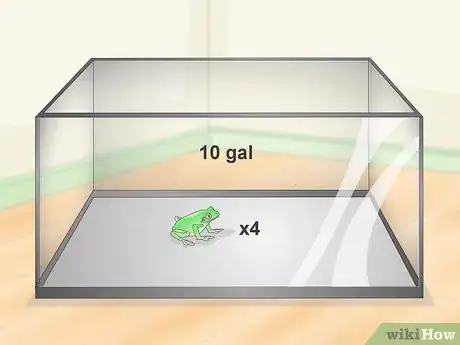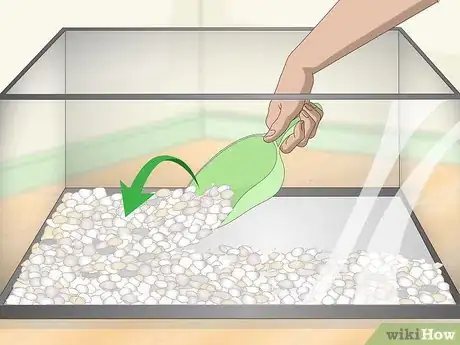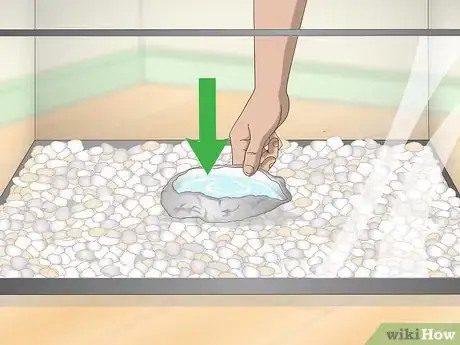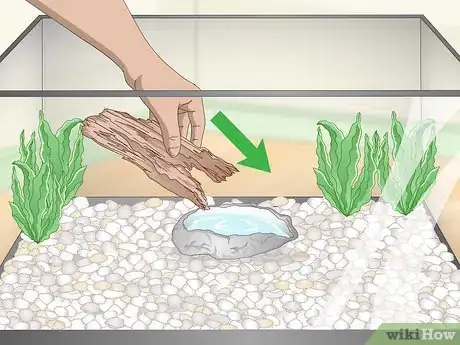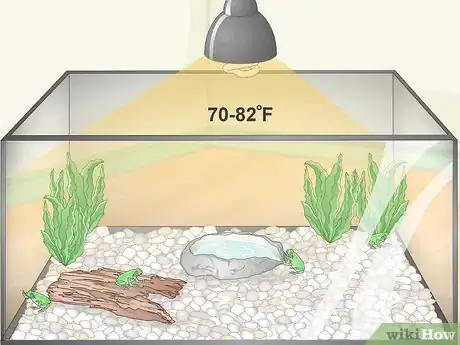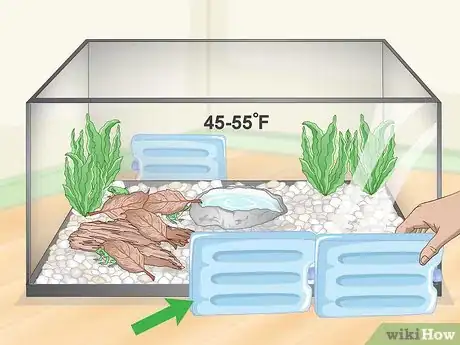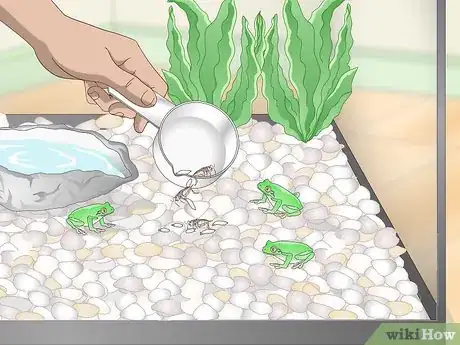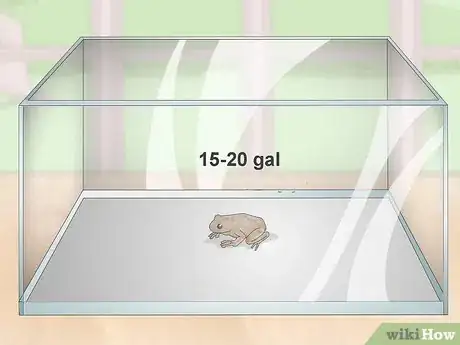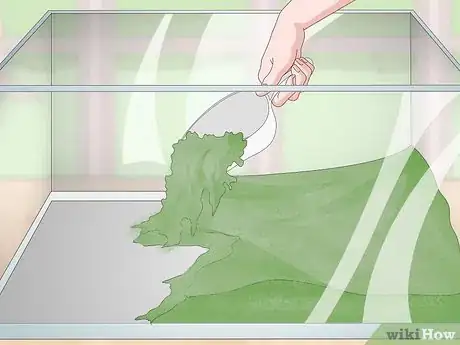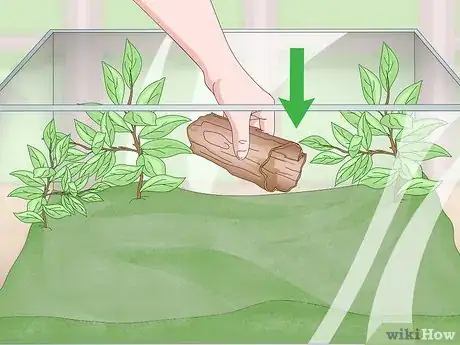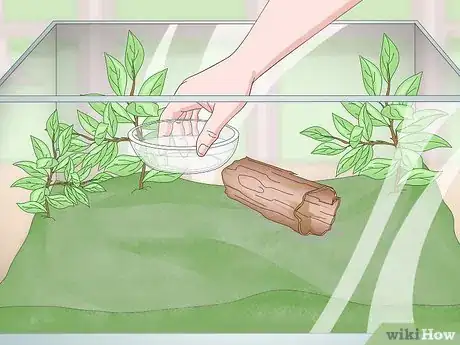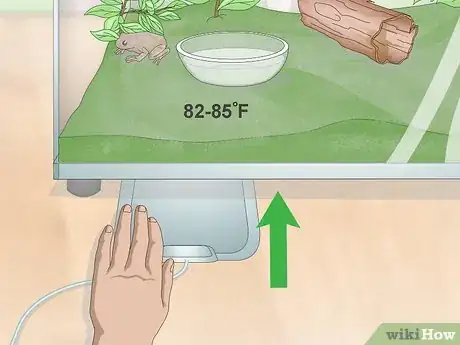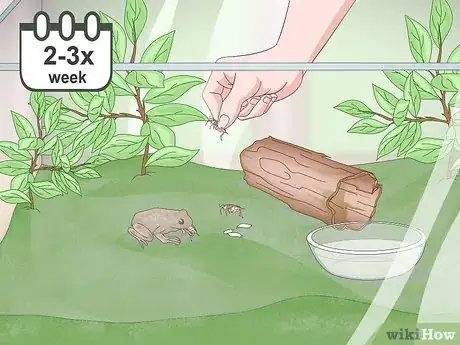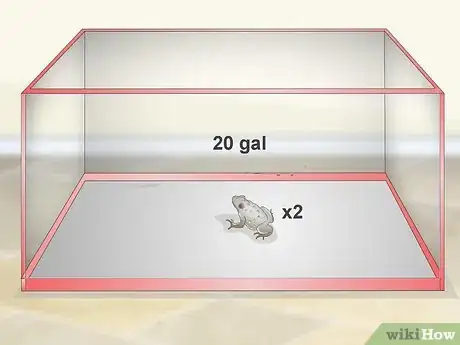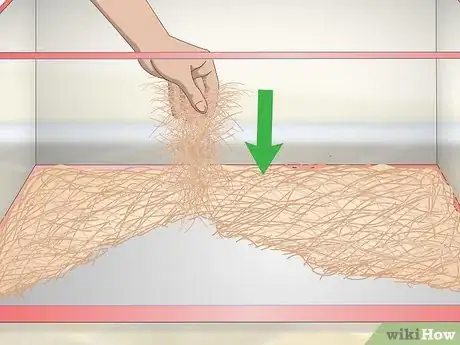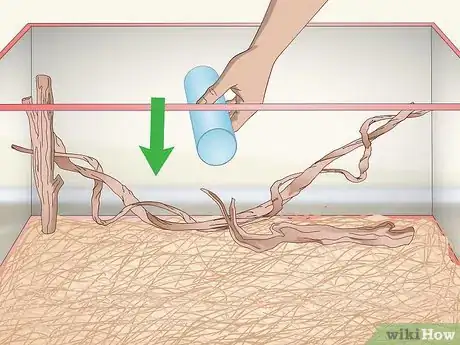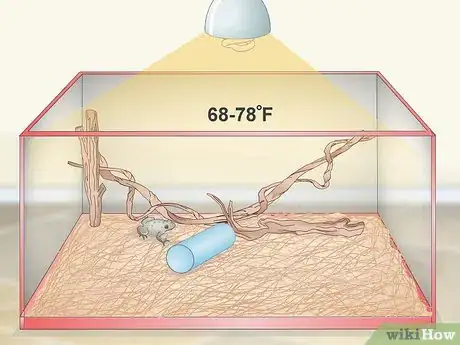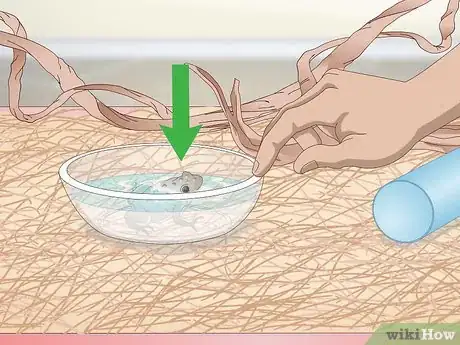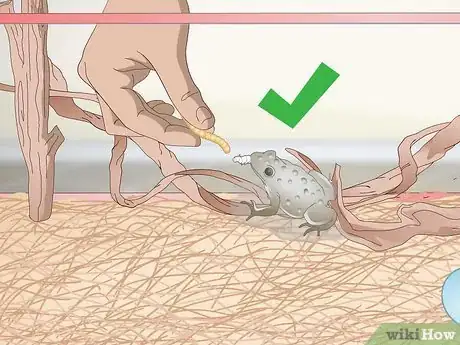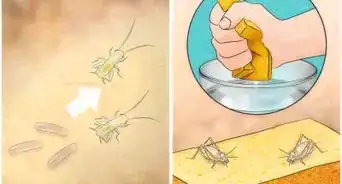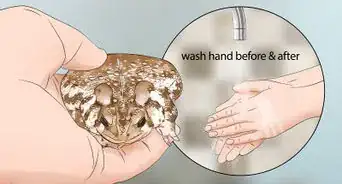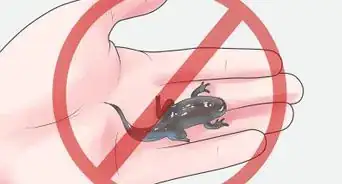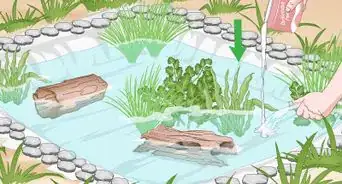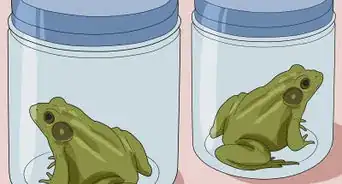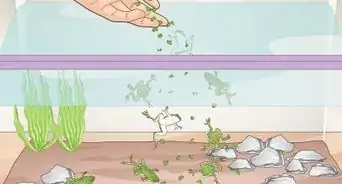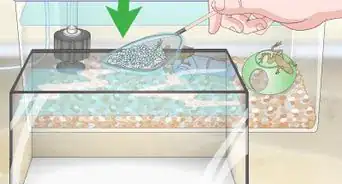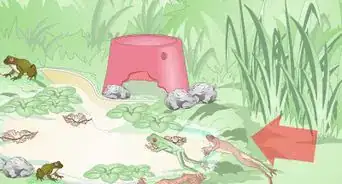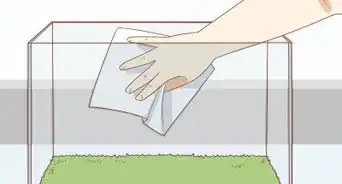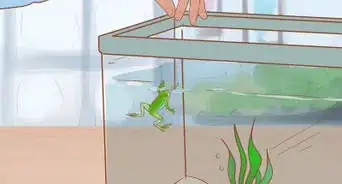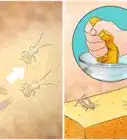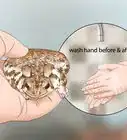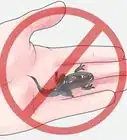This article was co-authored by wikiHow staff writer, Megaera Lorenz, PhD. Megaera Lorenz is an Egyptologist and Writer with over 20 years of experience in public education. In 2017, she graduated with her PhD in Egyptology from The University of Chicago, where she served for several years as a content advisor and program facilitator for the Oriental Institute Museum’s Public Education office. She has also developed and taught Egyptology courses at The University of Chicago and Loyola University Chicago.
There are 10 references cited in this article, which can be found at the bottom of the page.
wikiHow marks an article as reader-approved once it receives enough positive feedback. In this case, 87% of readers who voted found the article helpful, earning it our reader-approved status.
This article has been viewed 53,227 times.
Learn more...
Tree frogs are beautiful and interesting animals that you can find in almost any environment that has trees. They also make surprisingly low-maintenance pets! If you’ve captured a tree frog, you’ll need to set up an appropriate environment for it and offer it lots of fresh water and food. Consult a local wildlife guide to find out what kind of frog you have, since different species have different needs. A few popular and easy-to-catch varieties include the American green tree frog, the Cuban tree frog, and the gray tree frog.
Steps
Caring for Green Tree Frogs
-
1Provide a 10 US gal (38 L) aquarium for up to 4 frogs. Green tree frogs don’t require a lot of space. Choose a well-ventilated plastic or glass enclosure, preferably with a vertical orientation, since tree frogs love to climb.[1]
- You can keep as many as 4 green tree frogs comfortably in a 10 US gal (38 L) enclosure, but don’t try to keep more than that in such a small space. If any of your frogs are particularly aggressive, try reducing the number to 2 or 3.
- If you’d like to keep more frogs in one tank, you will need a larger space (e.g., about 30 gallons (110 L) for 6 to 8 frogs).
- These frogs are hearty eaters and may compete with each other for food, so it is important to avoid overcrowding the tank.
-
2Put large creek gravel in the tank as a substrate. Look for smooth, natural stones that are too large to easily fit in the frogs’ mouths. If your frog accidentally swallows small pieces of gravel, they could eventually injure or kill your frog. You can buy this type of large gravel in most pet shops or garden supply stores.[2]
- The gravel does not have to be deep—just put in enough to cover the bottom of the tank.
- If you want to grow live plants in your tank, you will need a soil substrate that is 1–3 inches (2.5–7.6 cm) deep, depending on how deeply your plants root. However, keep in mind that soil in a tank can become waterlogged. You will need to provide drainage to keep water from building up in the soil (e.g., by placing a layer of gravel about 1 inch (2.5 cm) deep under the soil).[3]
Advertisement -
3Give your frogs a shallow stoneware bowl to bathe in. Green tree frogs need to soak in water in order to stay healthy and hydrated. Set a shallow bowl on top of the substrate so that your frogs can climb in and submerge themselves whenever they like. Keep the bowl filled with clean, warm, dechlorinated water.[4]
- Change the water daily, or more often if you see fragments of food or other contaminants floating in it.
- You can also help your frogs stay hydrated by misting them once a day with dechlorinated water.[5]
-
4Place plastic plants and driftwood in the enclosure. Like all tree frogs, green tree frogs need places to climb and hide. You can create an attractive and natural-looking environment by decorating your tank with a few plastic plants and a driftwood log.[6]
- Take care not to overcrowd the tank with plants and décor, or your frogs may have a hard time finding their food. Try adding only 2-3 plants or décor pieces so that there is some open space at the bottom of the tank.
- If you prefer to use live plants, some good options include weeping figs, hibiscus, umbrella plants, Chinese evergreens, and ferns.[7]
-
5Keep the temperature in the tank between 70–82 °F (21–28 °C). Green tree frogs can tolerate cooler temperatures, but they are at their most active in a warmer environment. You can keep your frog’s enclosure warm with a heat lamp or under-tank heater.[8]
- Put a thermometer in the tank to make sure the enclosure is within the desired temperature range.
-
6Reduce the temperature to 45–55 °F (7–13 °C) if you want your frogs to hibernate. Green tree frogs go dormant during the cooler months. If you want to create a natural hibernation cycle for your frogs, set up a separate tank and cover the bottom with damp leaf litter where your frogs can hide. You’ll need to reduce the temperature of the tank to no more than 60 °F (16 °C) in order to encourage hibernation.[9]
- If you wish, you can allow your frogs to hibernate for several months, e.g., between November and April.
- Even while your frogs are hibernating, keep a bowl of fresh water available in case they wake up and want to soak.
- Don’t let the temperature in the tank drop to freezing or below, since this can kill your frogs. If the temperature rises above 60 °F (16 °C), the frogs may become active again.
- You can cool your tank by placing it in a colder area of your home (such as an unheated basement) or by putting ice packs around the tank.[10]
- There’s no need to encourage your frogs to hibernate in captivity.[11] However, you may wish to do so if you collect your own food for the frogs, since insects can become hard to find in the winter.
-
7Offer your frogs a variety of insects to eat. Green tree frogs will eat just about any insect or other invertebrate that they can fit inside their mouths. Some good options include crickets, moths, pill bugs, and earthworms.[12] Dust your frogs’ food with calcium and vitamin supplements from your pet store to ensure they are getting all the nutrients they need.
- Feed your adult tree frogs 2-3 times a week. Younger frogs should have food available at all times.[13]
- Give your frogs 2-3 crickets or other similarly-sized insects per feeding.
- During the warmer months, when insects are readily available, you can catch your own food for your frogs. Otherwise, you can buy feeder crickets from your local pet store.
Keeping Cuban Tree Frogs
-
1Get a 15–20 US gal (57–76 L) tank for a single Cuban tree frog. Cuban tree frogs can get up to 5 inches (13 cm) in length, so it’s important to give them a lot of space. They are also aggressive, and will try to eat any smaller frogs in their territory.[14]
- Look for a tank with a vertical orientation, since Cuban tree frogs like to climb.
- You may be able to house up to 3 Cuban tree frogs in a 20 US gal (76 L) tank, but look out for signs of aggression and make sure all your frogs are roughly the same size.[15]
-
2Use potting soil or peat moss as a substrate. You can create a natural and well-humidified environment for your frog by putting peat moss or a little potting soil in the bottom of the tank. However, keep in mind that these materials can become waterlogged easily. Paper towel is another good, low-maintenance option.[16]
- Avoid gravel or small chips of bark, since your frog might accidentally swallow them.
- The substrate does not need to be particularly deep unless you intend to grow live plants in it (in which case it should be 1–3 inches (2.5–7.6 cm) deep). Just use enough to cover the bottom of the tank.
-
3Put plants and logs in the tank so your frog can hide and climb. Cuban tree frogs love to be up high, and they also need places to hide in order to feel secure. Place branches and hollow logs in the enclosure to act as shelter and perching places. You can also put live or artificial plants in the tank.[17]
- If you choose to put live plants in the tank, you will need to provide a soil substrate and a plant light. Plants such as weeping figs, ferns, or umbrella plants work well. Keep your substrate 1–3 inches (2.5–7.6 cm) deep, or provide the plants with individual pots.
-
4Place a shallow soaking dish in your frog’s enclosure. Cuban tree frogs need constant access to clean, fresh water in order to stay hydrated. Put a shallow bowl or dish in the enclosure, and make sure it is large enough for your frog to climb in and submerge itself.[18]
- Keep the bowl filled with warm, clean, dechlorinated water at all times.
- You can also lightly mist the frog and its enclosure 2-3 times a day to keep the environment humid.
-
5Keep the enclosure between 82–85 °F (28–29 °C) during the day. Cuban tree frogs need to stay warm, although they can tolerate somewhat cooler temperatures at night. An under-tank heater is a good option for maintaining a proper temperature in your tank.[19]
- At night, you can lower the temperature in your frog’s enclosure to around 72–75 °F (22–24 °C).
- Put a thermometer in the tank so you can check that you are maintaining an appropriate temperature range.
- Avoid keeping the tank in a cold or drafty part of your home.
-
6Feed your frog a variety of insects 2-3 times a week. Cuban tree frogs can eat a variety of fairly large prey, such as crickets, cockroaches, locusts, moths, and beetles. Offer 2-5 food items per feeding. You can also feed them pinky mice once every 2-3 weeks if you want to give them a treat.[20]
- Dust your frog’s food with calcium and vitamin supplements. You can purchase these at most pet stores.
- While adult Cuban tree frogs only need to eat once every few days, you should feed juvenile frogs every day.
Providing for Gray Tree Frogs
-
1Keep up to 2 gray tree frogs in a 20 US gal (76 L) tank. Gray tree frogs are very active during their wakeful hours at night, and they like to have plenty of space to move around. Provide a tank that is at least 20 gallons (76 L) and put no more than 2 frogs in it. Choose a tank that is taller than it is wide.[21]
- If you’d like to keep more frogs, you will need a larger space (e.g., 30 gallons (110 L) for 3 frogs).
- These frogs may feel more secure in an environment that is not open on all sides. Try putting black poster board over 3 sides of the tank to create a space that feels more enclosed. Put the poster board on the outside of the tank so that it doesn’t get damp.
-
2Use coconut husk fiber or paper towels as a substrate. Other good substrate options include soil (especially if you plan to keep live plants in the tank) or paper towel. You can also use large, smooth river rocks.[22]
- Don’t use aquarium gravel or small bark fragments, since your frogs might accidentally swallow these.
- The substrate only needs to be deep enough to cover the bottom of the tank.
-
3Provide plenty of perches, climbing branches, and hiding places. Your gray tree frogs will feel safest and happiest if they have places to climb and hide. Offer furnishings such as branches, hollow logs, pieces of driftwood, or even lengths of PVC pipe.[23]
- You can provide shelter and cover by placing live or artificial plants around or over the climbing and perching areas. Weeping figs, hibiscus, or umbrella plants are good live plant options.
- If you’re concerned about the frogs being able to find their food, consider sticking to 2-3 climbing branches. Leave some open space at the bottom of the tank.
-
4Keep the enclosure between 68–78 °F (20–26 °C). Gray tree frogs can tolerate a wide range of temperatures, but they do best if the tank is kept around 68–78 °F (20–26 °C). You can allow the temperature to drop by 1-2°F (1°C) at night, but never expose your frogs to temperatures under 50 °F (10 °C). A low-wattage heat lamp or under-tank heater are good options for keeping your tank warm.[24]
- Place a thermometer in the tank to monitor the temperature inside.
- Don’t let the temperature in the tank rise above 90 °F (32 °C).
-
5Offer your frogs a shallow soaking dish. Keep a shallow bowl or dish in the enclosure so that your gray tree frogs can submerge themselves in it and soak at any time. Make sure the bowl is also constantly filled with clean, warm, dechlorinated water.[25]
- You can also maintain a healthy humidity level in the tank by misting the inside of the enclosure several times a week. If your home is very dry, mist the tank daily.
-
6Give your frogs a variety of insect foods. While crickets should be the staple of your frogs’ diet, you can also feed them a variety of other insects and invertebrates. Some good choices include flies, moths, silkworms, waxworms, and earthworms.[26]
- Make sure your frogs are getting the nutrients they need by sprinkling their food with a powdered calcium and vitamin supplement.
- While juvenile gray tree frogs need to eat every day, adults should only eat 2-3 times a week. Offer crickets for most meals, but occasionally alternate with some other food source (such as moths or waxworms) as a treat.
- Most gray tree frogs will eat 3-6 crickets or other similarly sized insects per feeding.
Community Q&A
-
QuestionHow many crickets should I be feeding my frog?
 Community AnswerIt always depends on their size. If they are smaller, such as 1 to 2 inches, give them 2 crickets every few days.
Community AnswerIt always depends on their size. If they are smaller, such as 1 to 2 inches, give them 2 crickets every few days. -
QuestionCan tree frogs eat crane flies/mosquitos?
 Community AnswerYes, the tree frogs can eat flies and mosquitos.
Community AnswerYes, the tree frogs can eat flies and mosquitos. -
QuestionCan my wild tree frogs eat web worms?
 Community AnswerYes, they can.
Community AnswerYes, they can.
Warnings
- Many tree frog species are protected or endangered. Always check the laws and regulations in your area to find out if you can legally capture and keep tree frogs.⧼thumbs_response⧽
References
- ↑ http://www.reptilesmagazine.com/Care-Sheets/Green-Treefrog/
- ↑ http://www.reptilesmagazine.com/Care-Sheets/Green-Treefrog/
- ↑ https://frogs.org.au/x/media/cs-caerulea.pdf
- ↑ http://www.reptilesmagazine.com/Care-Sheets/Green-Treefrog/
- ↑ http://www.anapsid.org/greentreefrog.html
- ↑ http://www.reptilesmagazine.com/Care-Sheets/Green-Treefrog/
- ↑ http://www.reptilesmagazine.com/Reptile-Care-For-Beginners/Plants-For-Reptiles-And-Amphibians/
- ↑ http://www.reptilesmagazine.com/Care-Sheets/Green-Treefrog/
- ↑ http://www.reptilesmagazine.com/Care-Sheets/Green-Treefrog/
- ↑ http://www.caudata.org/cc/articles/cooling.shtml
- ↑ https://www.eastbaytimes.com/2010/01/20/gary-bogue-pet-frogs-no-need-to-let-them-hibernate-in-winter/
- ↑ http://www.reptilesmagazine.com/Care-Sheets/Green-Treefrog/
- ↑ https://frogs.org.au/x/media/cs-caerulea.pdf
- ↑ http://www.wnyherpsociety.org/wp-content/uploads/2015/06/Cuban-Tree-Frog-Care-Sheet.pdf
- ↑ http://www.amphibiancare.com/frogs/caresheets/cubantreefrog.html
- ↑ http://www.wnyherpsociety.org/wp-content/uploads/2015/06/Cuban-Tree-Frog-Care-Sheet.pdf
- ↑ http://www.wnyherpsociety.org/wp-content/uploads/2015/06/Cuban-Tree-Frog-Care-Sheet.pdf
- ↑ http://www.wnyherpsociety.org/wp-content/uploads/2015/06/Cuban-Tree-Frog-Care-Sheet.pdf
- ↑ http://www.wnyherpsociety.org/wp-content/uploads/2015/06/Cuban-Tree-Frog-Care-Sheet.pdf
- ↑ http://www.wnyherpsociety.org/wp-content/uploads/2015/06/Cuban-Tree-Frog-Care-Sheet.pdf
- ↑ http://amphibiancare.com/2012/10/22/gray-tree-frog/
- ↑ http://amphibiancare.com/2012/10/22/gray-tree-frog/
- ↑ http://amphibiancare.com/2012/10/22/gray-tree-frog/
- ↑ http://amphibiancare.com/2012/10/22/gray-tree-frog/
- ↑ http://amphibiancare.com/2012/10/22/gray-tree-frog/
- ↑ http://amphibiancare.com/2012/10/22/gray-tree-frog/
- ↑ http://amphibiancare.com/2012/10/22/gray-tree-frog/
- ↑ https://www.nwf.org/Educational-Resources/Wildlife-Guide/Amphibians/Tree-Frogs
- ↑ http://www.wnyherpsociety.org/wp-content/uploads/2015/06/Cuban-Tree-Frog-Care-Sheet.pdf
- ↑ http://www.anapsid.org/greentreefrog.html
